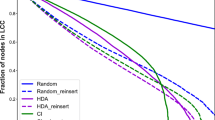Abstract
The interplay between topology changes and the redistribution of traffic plays a significant role in many real-world networks. In this paper we study how the load of the remaining network changes when nodes are removed. This removal operation can model attacks and errors in networks, or the planned control of network topology. We consider a scenario similar to the data communication networks, and measure the load of a node by its betweenness centrality. By analysis and simulations, we show that when a single node is removed, the change of the remaining network’s load is positively correlated with the degree of the removed node. In multiple-node removal, by comparing several node removal schemes, we show in detail how significantly different the change of the remaining network’s load will be between starting the removal from small degree/betweenness nodes and from large degree/betweenness nodes. Moreover, when starting the removal from small degree/betweenness nodes, we not only observe that the remaining network’s load decreases, which is consistent with previous studies, but also find that the load of hubs keeps decreasing. These results help us to make a deeper understanding about the dynamics after topology changes, and are useful in planned control of network topology.
Similar content being viewed by others
References
M. Sachtjen, B. Carreras, V. Lynch, Phys. Rev. E 61, 4877 (2000)
R. Kinney, P. Crucitti, R. Albert, V. Latora, Eur. Phys. J. B 46, 101 (2005)
X. Huang, I. Vodenska, S. Havlin, H.E. Stanley, Sci. Rep. 3, 1219 (2013)
C. Borrvall, B. Ebenman, T. Jonsson, Ecol. Lett. 3, 131 (2000)
P. Holme, B.J. Kim, Phys. Rev. E 65, 066109 (2002)
A.E. Motter, Y.C. Lai, Phys. Rev. E 66, 065102 (2002)
Y. Moreno, J. Gómez, A. Pacheco, Europhys. Lett. 58, 630 (2002)
Y. Moreno, R. Pastor-Satorras, A. Vázquez, A. Vespignani, Europhys. Lett. 62, 292 (2003)
J. Wang, L. Rong, L. Zhang, Z. Zhang, Physica A 387, 6671 (2008)
F. Tan, Y. Xia, W. Zhang, X. Jin, Europhys. Lett. 102, 28009 (2013)
Y. Xia, J. Fan, D. Hill, Physica A 389, 1281 (2010)
L.C. Freeman, Sociometry 40, 35 (1977)
K.I. Goh, B. Kahng, D. Kim, Phys. Rev. Lett. 87, 278701 (2001)
J.H. Chang, L. Tassiulas, Energy conserving routing in wireless ad-hoc networks, in INFOCOM 2000. Nineteenth Annual Joint Conference of the IEEE Computer and Communications Societies. Proceedings IEEE (IEEE, 2000), Vol. 1, pp. 22–31
J. Yick, B. Mukherjee, D. Ghosal, Comput. Netw. 52, 2292 (2008)
M. Li, B. Yang, A survey on topology issues in wireless sensor network, in Proceedings of the International Conference on Wireless Networks (2006)
U. Brandes, J. Math. Soc. 25, 163 (2001)
M. Barthelemy, Eur. Phys. J. B 38, 163 (2004)
J.A. Hołyst, J. Sienkiewicz, A. Fronczak, P. Fronczak, K. Suchecki, Phys. Rev. E 72, 026108 (2005)
P. Erdős, A. Rényi, Publ. Math. Inst. Hungar. Acad. Sci. 5, 17 (1960)
D.J. Watts, S.H. Strogatz, Nature 393, 440 (1998)
A.L. Barabási, R. Albert, Science 286, 509 (1999)
Q. Cao, T. Abdelzaher, T. He, J. Stankovic, Towards optimal sleep scheduling in sensor networks for rare-event detection, in Proceedings of the 4th international symposium on Information processing in sensor networks (IEEE Press, 2005), p. 4
A.E. Motter, Phys. Rev. Lett. 93, 098701 (2004)
Author information
Authors and Affiliations
Corresponding author
Rights and permissions
About this article
Cite this article
Ouyang, B., Jin, X., Xia, Y. et al. Change of network load due to node removal. Eur. Phys. J. B 87, 52 (2014). https://doi.org/10.1140/epjb/e2014-40723-3
Received:
Revised:
Published:
DOI: https://doi.org/10.1140/epjb/e2014-40723-3




